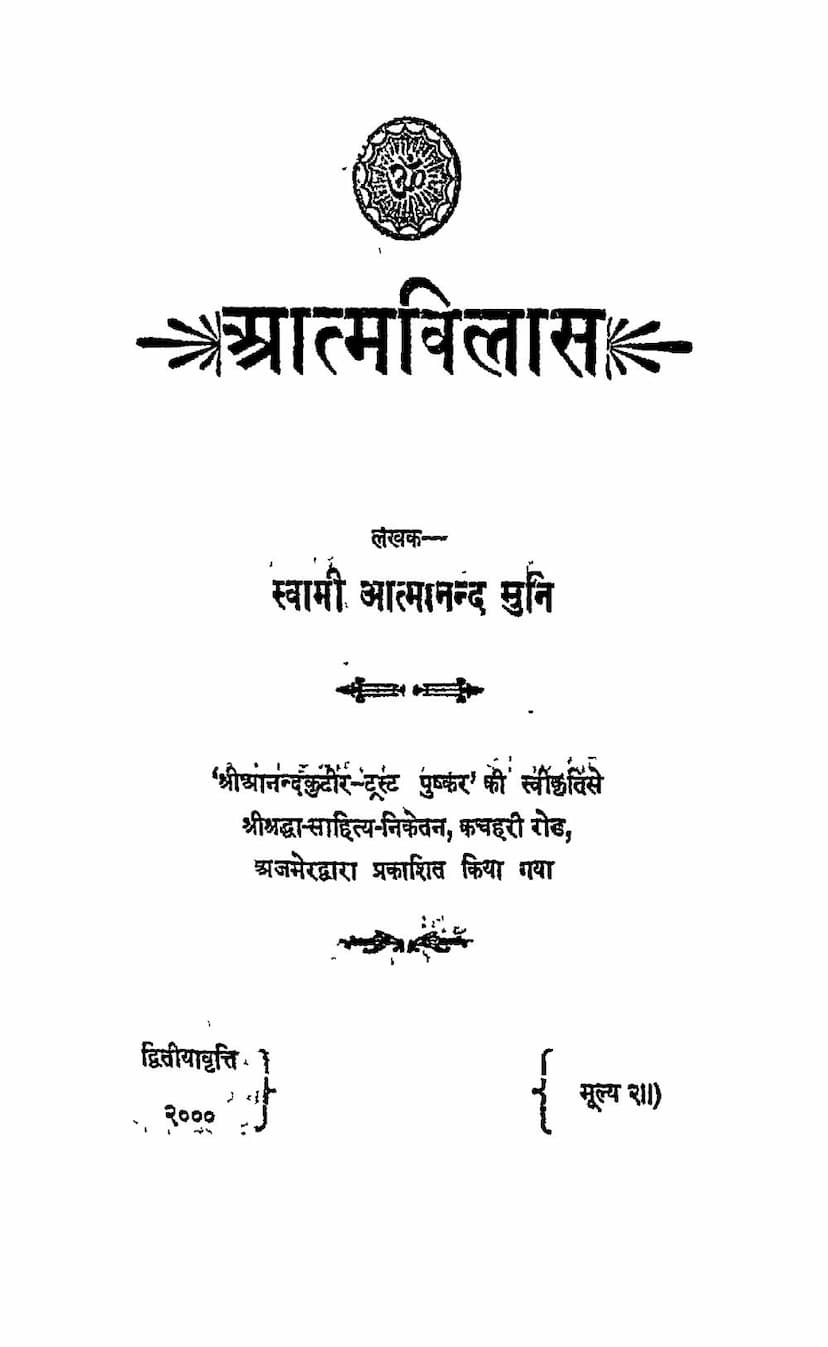Atmavilas
Added to library: September 1, 2025

Summary
The book "Atmavilas" by Swami Atmanand Muni is a profound spiritual discourse that aims to guide the reader towards self-realization and spiritual liberation. The title itself, "Atmavilas," translates to "The Play of the Soul," suggesting a journey of understanding the soul's experiences and its ultimate nature.
The book is divided into two main parts, along with introductory and supplementary sections. The primary focus is on exploring the nature of "Punya" (merit/virtue) and "Papa" (demerit/sin) and how they influence the soul's journey. It delves into the broader concept of "Sadharan Dharma" (common/universal dharma), which encompasses principles applicable to all beings.
Key Themes and Concepts:
- The Nature of Reality and the Soul: The book extensively explores the difference between the transient physical world and the eternal, unchanging soul (Atma). It emphasizes that true happiness and liberation lie in understanding the soul's true nature, which is distinct from the body, mind, and senses.
- Cause and Effect (Karma): A significant portion of the text is dedicated to the workings of karma, explaining how actions (karma) driven by various intentions and desires create the cycle of birth and death. It elaborates on how purity and impurity of intention, rather than the action itself, determine the karmic consequences.
- The Path of Evolution: The book traces the soul's evolutionary journey through different forms of existence, from inanimate objects to plants, animals, and finally to human birth. It explains how the development of consciousness, the presence of the "doer-enjoyer" ego (kartrutva-ahankar), and the pursuit of worldly pleasures (sukha) create bondage. Human birth is highlighted as a unique opportunity for spiritual advancement due to the developed intellect and the capacity for discrimination.
- Distinguishing True Happiness from Worldly Pleasure: The author meticulously dissects worldly pleasures, demonstrating their impermanent and ultimately painful nature. True, lasting happiness, the book argues, is found in the cessation of desires and the realization of the soul's intrinsic bliss, which is independent of external circumstances.
- The Role of Desires and Attachment: Desires (trishna) and attachments (mamata, ahamkara) are identified as the root cause of suffering and bondage. The book advocates for detachment and renunciation, not as a physical act, but as a mental and intellectual disengagement from worldly allurements.
- The Concept of Dharma: Dharma is explored in its multifaceted aspects. It is explained as that which uphms the universe, the principles of righteous living, and the path that leads to both worldly prosperity (abhyudaya) and spiritual liberation (nihshreyas). The importance of acting according to one's innate nature and duty (swadharma) is stressed.
- The Importance of Renunciation and Sacrifice: True happiness and spiritual progress are linked to renunciation (tyaga) and sacrifice. The book illustrates through stories and philosophical arguments that giving up attachments leads to gaining true spiritual wealth and fulfillment.
- Devotion and Worship (Bhakti-Yoga): The text elaborates on the different stages and forms of devotion, from initial reverence (shraddha) towards elders and scriptures to the ultimate sublimation of the self in divine love. It emphasizes that sincere devotion, even towards a manifested form (saguna bhakti), can lead to the realization of the formless Absolute (nirguna).
- The Power of Name and Meditation: The book highlights the efficacy of remembering and chanting the divine name (nama-smaran/japa) and focusing the mind (manas-ekagrata) as potent tools for spiritual purification and self-realization.
- Critique of Tilak's Interpretation: A significant portion of the second part of the book is dedicated to a critique of Lokmanya Tilak's interpretation of the Bhagavad Gita, particularly his emphasis on Karma Yoga (action) as the primary path to liberation over Jnana Yoga (knowledge) and Sannyasa (renunciation). The author respectfully refutes Tilak's views, arguing that while selfless action is important, ultimate liberation is achieved through knowledge and the transcendence of ego, which often involves renunciation in its deeper sense.
- The Ultimate Goal: The ultimate goal expounded is the realization of the soul's true identity with the Universal Soul (Brahman), leading to a state of eternal peace, bliss, and liberation from the cycle of birth and death.
Structure and Approach:
The book employs a narrative and argumentative style, often using stories, analogies, and scriptural references to explain complex spiritual concepts. The author's approach is philosophical and introspective, encouraging the reader to look within and understand the subtler aspects of existence. The critique of opposing viewpoints, such as Tilak's interpretation, adds intellectual depth and demonstrates the author's commitment to presenting what he considers the unadulterated truth.
In essence, "Atmavilas" offers a comprehensive guide to understanding the spiritual path from a Jain perspective, emphasizing self-discipline, ethical conduct, detachment, devotion, and the ultimate pursuit of self-knowledge, all aimed at achieving liberation and realizing the soul's true, blissful nature.